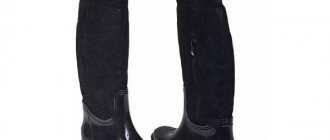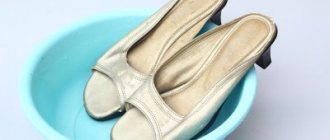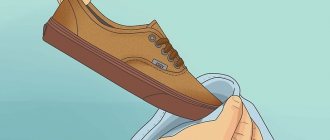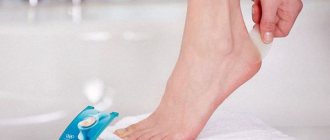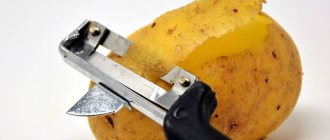Shoes need to be washed and cleaned
How to clean suede shoes, nubuck shoes
Suede shoes must be dry. Use a special brush for suede shoes. Please note that it is better not to clean light suede with a dark brush. Light brushes are sold for light suede.
In hard-to-reach places, clean suede with a rubber eraser. If the shoes are heavily soiled, you can hold them over steam, but so that the boots do not become wet. It is also recommended to use various foams when cleaning, but as practice shows, they do not do their job well. It is better to try to wipe off severe stains with a mixture of ammonia and soap suds; the same solution helps to remove greasy stains.
Dry dirt and dust can be easily removed with a sticky clothes roller.
How to care for leather boots
The boots are washed and then wiped dry. Before applying the cream paint, you can revive the boots with hand cream, or even better, Zorka cow udder cream, which is sold in pet stores.
After the cream has been absorbed, you can use regular cream or shoe paint.
Preparing the inside of the shoe
After you have cleaned the top of the shoe, start preparing the inside. Pull out the insoles. Wash them thoroughly and dry them. If moisture gets into the shoes, or your feet sweat in warm socks, then the insoles remain wet for a long time. To prevent mold from growing on them, they must be washed and dried. Place a few pieces of cotton wool soaked in vinegar diluted with water into your shoes. Place the boots in sealable plastic bags and leave for 12 hours. This will help get rid of the unpleasant odor.
How to store
It is best to store shoes in boxes. There are also special trunks for storing shoes, but you need to understand that shoes must “breathe,” so when buying a polyethylene trunk, make sure that it has ventilation.
To avoid mixing up the boxes, you can print out photos of each pair of shoes and make a label. You can leave a “window” in the boxes, in which you can see which pair is stored.
Some housewives store shoes in a linen drawer under the sofa or bed. Shoes are either covered with an old sheet to prevent dust, or a separate clothes bag is sewn for each shoe. The bags can be signed.
Sometimes boxes of different shapes are difficult to arrange so that the entire cabinet space is occupied. Therefore, some people use one or two boxes, which will completely take up the space intended for storing shoes. This option is also convenient when looking for shoes.
It is not recommended to store shoes made from natural materials on the balcony. In summer, the skin can simply dry out.
Preparation for storage
Winter shoes are subject to extreme stress. Temperature change: from +25 degrees indoors to -20 degrees outside, dirt, water. The reagents that are sprinkled on the streets and sand, which acts as an abrasive on the sole and coating, have a particularly negative impact on the condition of shoes. By the time of preparation for storage, the shoes are not in the best shape. A network of microcracks appears on the skin. Dirt, sand and salts get clogged into microcracks. Shoes cannot be stored in this form.
Saving the hallway
During the period of active snow melting on shoes, a lot of dirt is brought into the house. There are several options for keeping your hallway clean.
During the bad weather season, lay a fleecy rubber-based rug at the front door. It absorbs dirt well and prevents it from getting onto the floor. There are other options, but a rubber mat works best for dealing with dirty, melted snow.
During periods of slush, you can place a tray or box with pebbles or small stones under your shoes in the hallway. An absorbent cork mat is also used as an absorbent material.
PS If your shoes are wet and you don’t have a shoe dryer, you can use the old method - push newspapers or napkins lightly inside, they absorb moisture well. For emergency drying, you can use a vacuum cleaner by pushing the hose first into one shoe, then into the other.
Uralweb
Placing things in the apartment
Now that you have tons of bags and containers packed with your things, all that remains is to compactly stack them in your apartment:
- Place the covers with the clothes back into the wardrobe, leaving a few centimeters between them so that the fur or fabric does not wrinkle in the summer months;
- vacuum bags are placed on the shelves of the wardrobe, observing the condition - heavy things are removed, light things are on top;
- containers with woolen clothes hidden under hangers in the closet - this way we will protect them from dust;
- For boxes with other things and shoes, we use any free space - under the bed, at the top of the closet, in the corner of the room.
Tip: Buy special anti-moth bags and put them in boxes - you can use cotton balls soaked in essential oils and put them in the closet. Moths really don’t like the aromas of lavender, cypress, cedar, rosemary, and mint.
Maintenance during use: cleaning and drying
After the next “outing”, leather shoes must be cleaned from dust and dirt. This is especially true for periods when it is damp and slushy outside. Dirt should not be removed with a stream from a hot tap, but with a warm, damp cloth made of soft natural material (for example, flannel or calico) or a sponge. Moreover, this applies not only to the top of the shoe, but also to the sole.
After cleaning the product from dirt, wipe the leather surface dry with a soft cloth and leave to dry. In no case should you place leather products on a radiator or heater or use electric dryers to artificially speed up the process.
During wearing, use disinfectants, especially when caring for winter shoes, shoes or boots. Then unpleasant odors will never cause trouble, and the fur inside the pair will retain its quality and appearance for a long time.
Caring for leather shoes in winter differs in that white salt stains appear on the products. Such stains should be removed with a soft cloth moistened with suntan lotion or body milk. Rub strong and prominent marks or stains with juice squeezed from onions, let them dry and the stains will disappear.
To ensure that leather shoes retain their shape, it is better to put spacers inside when drying or insert crumpled dry newspapers. If the couple gets very wet, the newspapers need to be changed several times. How to quickly and safely organize drying, read the article “How to quickly dry shoes.”
How to remove scratches from leather shoes
During wear, leather shoes or boots may develop cracks and scratches, which greatly spoil the aesthetic appearance of the product. You can remove such defects using improvised means at home. Any procedures are performed only with clean and well-dried shoes. To remove scratches from leather products, use the following products:
- Nail polish or a colloxylin-based chemical will help cover up scratches and rough spots. The selected composition is applied to the damaged area of the shoes and to the areas under the damage;
- Professional glue for leather products is applied to the area of abrasions and then pressed with a finger wrapped in fabric. Hold the product like this for five minutes. The glued material will set and last a long time. For thin leather, you can use classic superglue;
- Match the oil paint to the color of your boots or other pair of leather shoes. Take and melt colorless shoe wax, then add a few drops of paint. Apply the resulting product to the damaged surface in a thin layer and leave until completely dry;
- An alcohol marker will help paint over and remove small scratches or grooves. To do this, select a marker that matches the color of the couple and carefully paint over the damaged area. Then treat the surface with a suitable shoe polish and polish the products with a soft cloth;
- Olive oil will help correct minor defects. To do this, soak a cotton pad or soft cloth in the oil and wipe the damaged area using circular movements. When the products dry, the scratches will disappear;
- Using an iron is a radical and effective method for removing scratches. In this case, first treat the damaged area with olive oil. Place a damp cloth on the treated area, take a heated iron and set the “steam” function. Steam over the surface for some distance. When exposed to warm air, the oil will penetrate deeper into the skin.
Liquid leather is a modern and safe product that will allow you to repair defects in leather products at home. To do this, select the composition to match the color of the couple and apply it evenly in a thin layer over the entire surface so that after drying, the treated area and its borders do not stand out.
Caring for new shoes
Immediately after purchase, to extend the service life, any leather shoes must undergo a number of mandatory procedures. Proper care of new leather shoes, first of all, includes taking the new thing out of the box and letting it sit for a couple of days. This will allow the leather to straighten after storage in the warehouse and take its natural shape after transportation.
Then you need to treat the shoes with an aerosol or cream with increased water-repellent properties, allowing the composition to be absorbed into the skin. To protect against moisture, you can use folk compositions.
Natural leather is coated with wax. It is recommended to wipe patent leather shoes with castor oil or Vaseline. This will create an additional barrier to street dampness. The rating of shoe polishes will tell you which care product to choose.
the washing up
Before storing winter boots and boots, they should be washed. Leather products should not be washed under running hot water. It is best to wipe the surface with a soft, wet cloth.
You should not use hard sponges for washing, as they scratch the surface and can damage the paint layer. If the surface is very dirty, it should be washed with a cloth and soapy water.
Before storing suede winter shoes, thoroughly clean them with a special brush. Manufacturers recommend using special sprays to care for suede. But it’s easier and much cheaper to wash natural suede with soapy water and a cloth. You should not rub such material too hard, nor should you wet it too much with water.
Shoes for the winter (when preparing them for storage) need to be disinfected from the inside. The insoles should be removed and washed in a powder solution, and the inside of the boots themselves should be wiped with soapy water and a rag and treated with a weak peroxide solution. Peroxide will help remove unpleasant odors and kill pathogenic bacteria. Many housewives treat the inside of winter boots and shoes with a vinegar solution.
You can also use special means for disinfection. It is best to choose an antiseptic aerosol that perfectly removes fungus and unpleasant odors.
After washing, winter boots must be dried. Products made from genuine leather are dried only at room temperature and away from heating devices. Do not use a hair dryer or place shoes on a radiator. If you plan to dry boots or boots, then they need to be opened wide. There should not be a drop of moisture left on the skin or inside the product.


